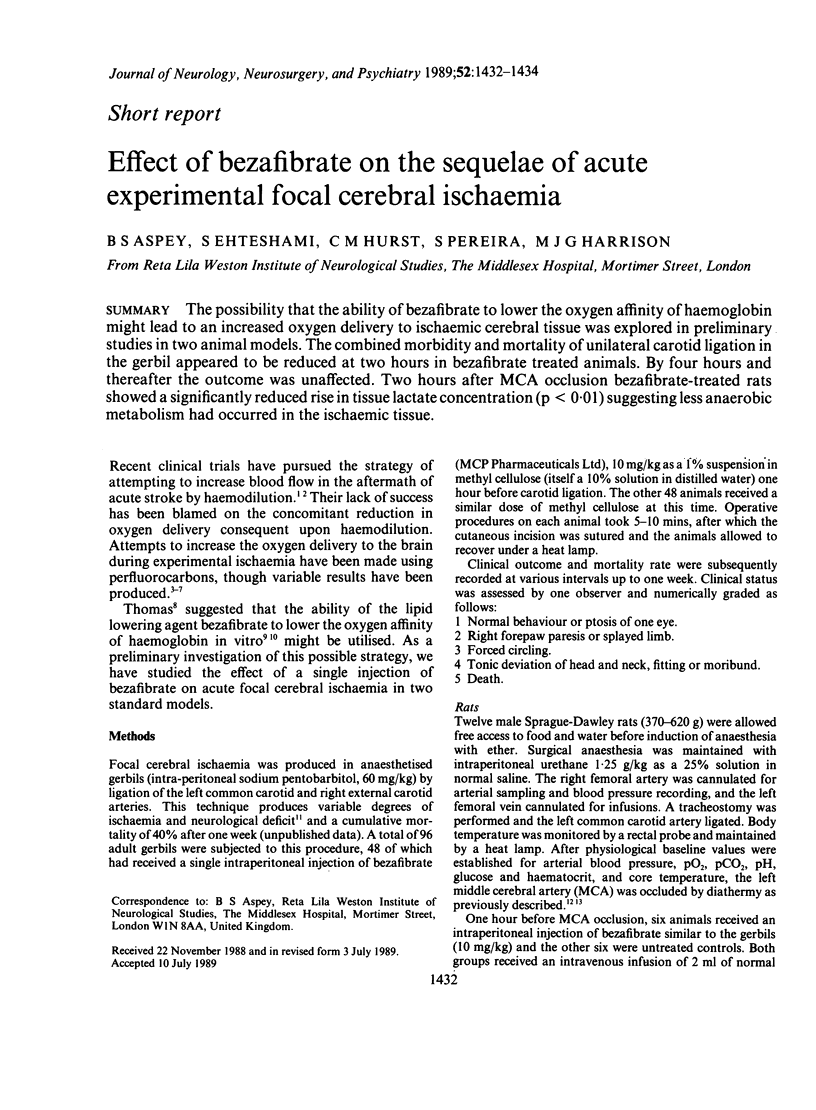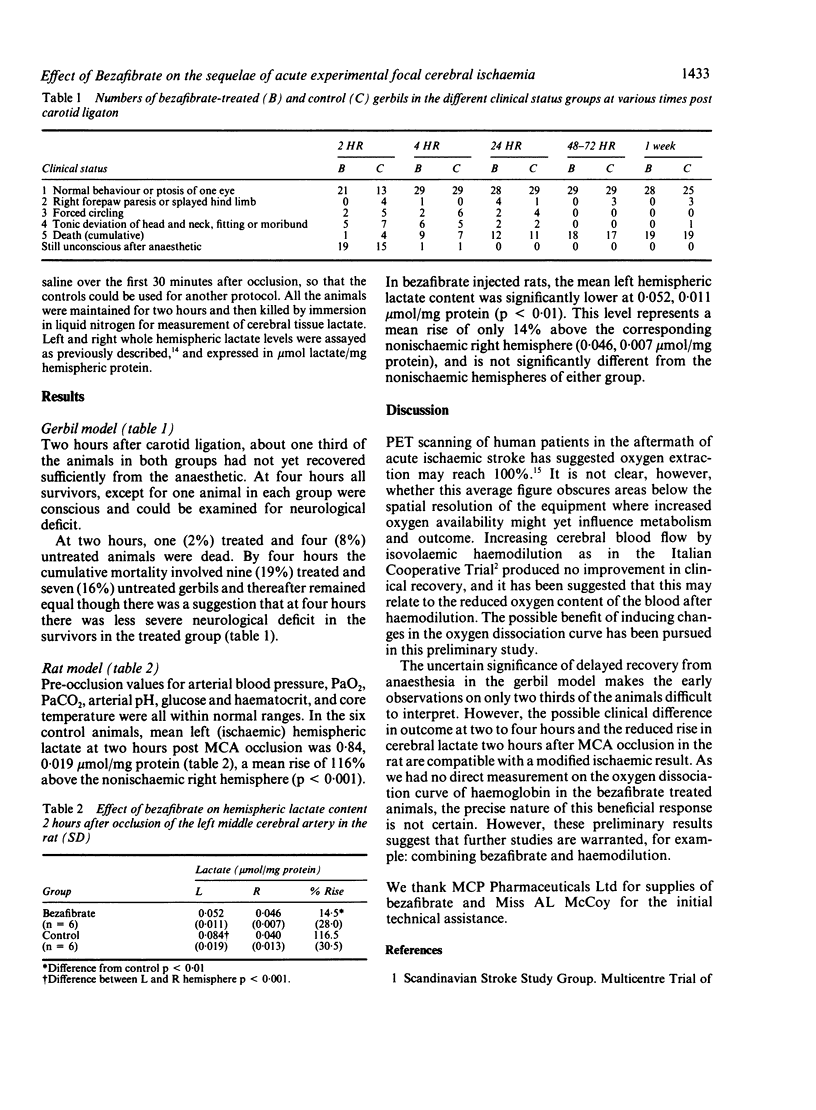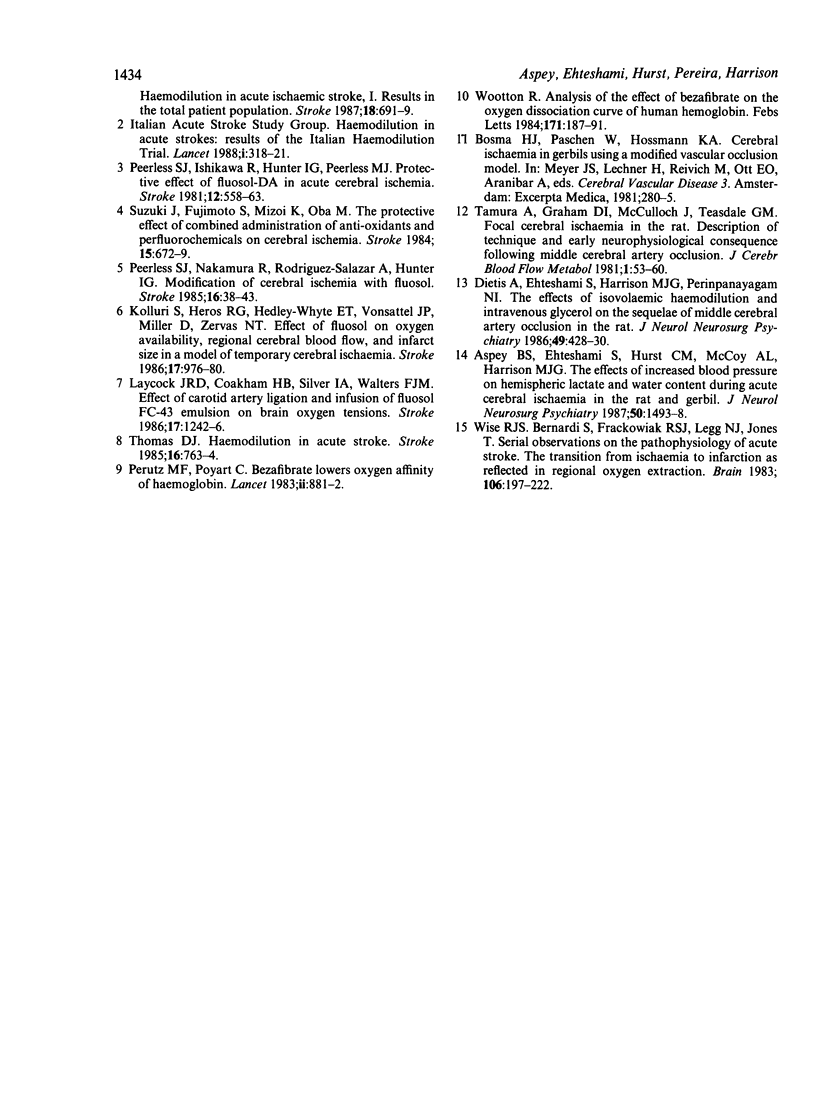Abstract
The possibility that the ability of bezafibrate to lower the oxygen affinity of haemoglobin might lead to an increased oxygen delivery to ischaemic cerebral tissue was explored in preliminary studies in two animal models. The combined morbidity and mortality of unilateral carotid ligation in the gerbil appeared to be reduced at two hours in bezafibrate treated animals. By four hours and thereafter the outcome was unaffected. Two hours after MCA occlusion bezafibrate-treated rats showed a significantly reduced rise in tissue lactate concentration (p less than 0.01) suggesting less anaerobic metabolism had occurred in the ischaemic tissue.
Full text
PDF


Selected References
These references are in PubMed. This may not be the complete list of references from this article.
- Aspey B. S., Ehteshami S., Hurst C. M., McCoy A. L., Harrison M. J. The effect of increased blood pressure on hemispheric lactate and water content during acute cerebral ischaemia in the rat and gerbil. J Neurol Neurosurg Psychiatry. 1987 Nov;50(11):1493–1498. doi: 10.1136/jnnp.50.11.1493. [DOI] [PMC free article] [PubMed] [Google Scholar]
- Dietis A., Ehteshami S., Harrison M. J., Perinpanayagam N. I. The effect of isovolaemic haemodilution and intravenous glycerol on the sequelae of middle cerebral artery occlusion in the rat. J Neurol Neurosurg Psychiatry. 1986 Apr;49(4):428–430. doi: 10.1136/jnnp.49.4.428. [DOI] [PMC free article] [PubMed] [Google Scholar]
- Kolluri S., Heros R. C., Hedley-Whyte E. T., Vonsattel J. P., Miller D., Zervas N. T. Effect of Fluosol on oxygen availability, regional cerebral blood flow, and infarct size in a model of temporary focal cerebral ischemia. Stroke. 1986 Sep-Oct;17(5):976–980. doi: 10.1161/01.str.17.5.976. [DOI] [PubMed] [Google Scholar]
- Laycock J. R., Coakham H. B., Silver I. A., Walters F. J. Effect of carotid artery ligation and infusion of fluosol FC-43 emulsion on brain surface oxygen tensions. Stroke. 1986 Nov-Dec;17(6):1242–1246. doi: 10.1161/01.str.17.6.1242. [DOI] [PubMed] [Google Scholar]
- Peerless S. J., Ishikawa R., Hunter I. G., Peerless M. J. Protective effect of Fluosol-DA in acute cerebral ischemia. Stroke. 1981 Sep-Oct;12(5):558–563. doi: 10.1161/01.str.12.5.558. [DOI] [PubMed] [Google Scholar]
- Peerless S. J., Nakamura R., Rodriguez-Salazar A., Hunter I. G. Modification of cerebral ischemia with Fluosol. Stroke. 1985 Jan-Feb;16(1):38–43. doi: 10.1161/01.str.16.1.38. [DOI] [PubMed] [Google Scholar]
- Perutz M. F., Poyart C. Bezafibrate lowers oxygen affinity of haemoglobin. Lancet. 1983 Oct 15;2(8355):881–882. doi: 10.1016/s0140-6736(83)90870-x. [DOI] [PubMed] [Google Scholar]
- Suzuki J., Fujimoto S., Mizoi K., Oba M. The protective effect of combined administration of anti-oxidants and perfluorochemicals on cerebral ischemia. Stroke. 1984 Jul-Aug;15(4):672–679. doi: 10.1161/01.str.15.4.672. [DOI] [PubMed] [Google Scholar]
- Thomas D. J. Hemodilution in acute stroke. Stroke. 1985 Sep-Oct;16(5):763–764. doi: 10.1161/01.str.16.5.763. [DOI] [PubMed] [Google Scholar]
- Wise R. J., Bernardi S., Frackowiak R. S., Legg N. J., Jones T. Serial observations on the pathophysiology of acute stroke. The transition from ischaemia to infarction as reflected in regional oxygen extraction. Brain. 1983 Mar;106(Pt 1):197–222. doi: 10.1093/brain/106.1.197. [DOI] [PubMed] [Google Scholar]
- Wootton R. Analysis of the effect of bezafibrate on the oxygen dissociation curve of human hemoglobin. FEBS Lett. 1984 Jun 11;171(2):187–191. doi: 10.1016/0014-5793(84)80485-8. [DOI] [PubMed] [Google Scholar]


